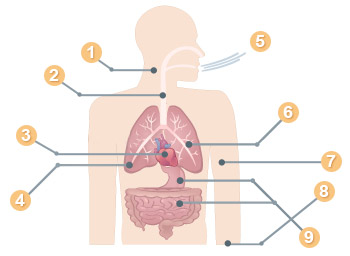Fibrosis usually occurs due to the lungs reacting to and repairing damage to lung tissue over a long period of time; such as, continuous exposure to asbestos fibers. This reparative scar tissue replaces normal lung tissue, and an excess amount of scar tissue can cause reduced pulmonary function.
More Asbestosis Symptoms
During exposure, asbestos fibers are inhaled, and they can become lodged in lung tissue. The sharp, straight shape of the fibers makes them difficult for a body to dislodge and expel. Once in a body for a long period, the fibers cause irritation, inflammation and scarring, which cause symptoms that primarily affect the lungs.In most asbestosis patients, symptoms develop within 20 to 30 years after being exposed to asbestos. If someone is exposed to asbestos for a long time, a decade or more, the latency period of symptom development is shorter: closer to 20 years.
Common Asbestosis Symptoms
Although the severity and frequency of symptoms can vary among patients at the time of diagnosis, the most common asbestosis symptoms include:
-
Swelling in the neck or face
- Difficulty swallowing
- High blood pressure
- Blood in sputum
- Crackling sound when breathing
- Shortness of breath
- Hyper tension
- Finger deformity
-
Loss of weight/appetite
What Causes Symptoms?
Lung scarring, or fibrosis, is the direct cause for the coughing and shortness of breath symptoms most commonly associated with asbestosis.Shortness of breath arises because of pleural thickening, the thickening of the lining of the lungs, caused by the longtime presence of asbestos fibers, or pleural effusion, the buildup of fluid between the chest wall and the lungs. Effusions can be caused by many conditions (pneumonia, lupus, congestive heart failure) and can stem from inflammation of the lungs. The thickening and effusions constrict movement of the lungs and eventually the heart. At that point, neither organ expands or contracts properly, which leads to shortness of breath and more fluid build up.
Asbestosis can set in motion a cycle of conditions. The disease prevents lungs from fully oxygenating blood, forcing the heart to work harder. As the heart works harder, blood pressure increases. As blood pressure increases, fluid builds up around the heart and lungs, which can lead to swelling in the neck and face, which in turns can lead to difficulty swallowing.
Fluid up can also build up in the abdomen, creating bloating or tenderness, which can lead to a loss of appetite and potential weight loss. In advanced cases, fluid retention, if untreated, will lead to finger deformity, known as clubbing.
Relieving Asbestosis Symptoms
Although there is no cure for asbestosis, doctors recommend several treatment options to relievesymptoms, and there are some changes to lifestyle and diet and patients can do to feel better. Some medications are available to help with coughing and pain. Other treatments include the use of inhalers, supplemental oxygen and antibiotics.



No comments:
Post a Comment